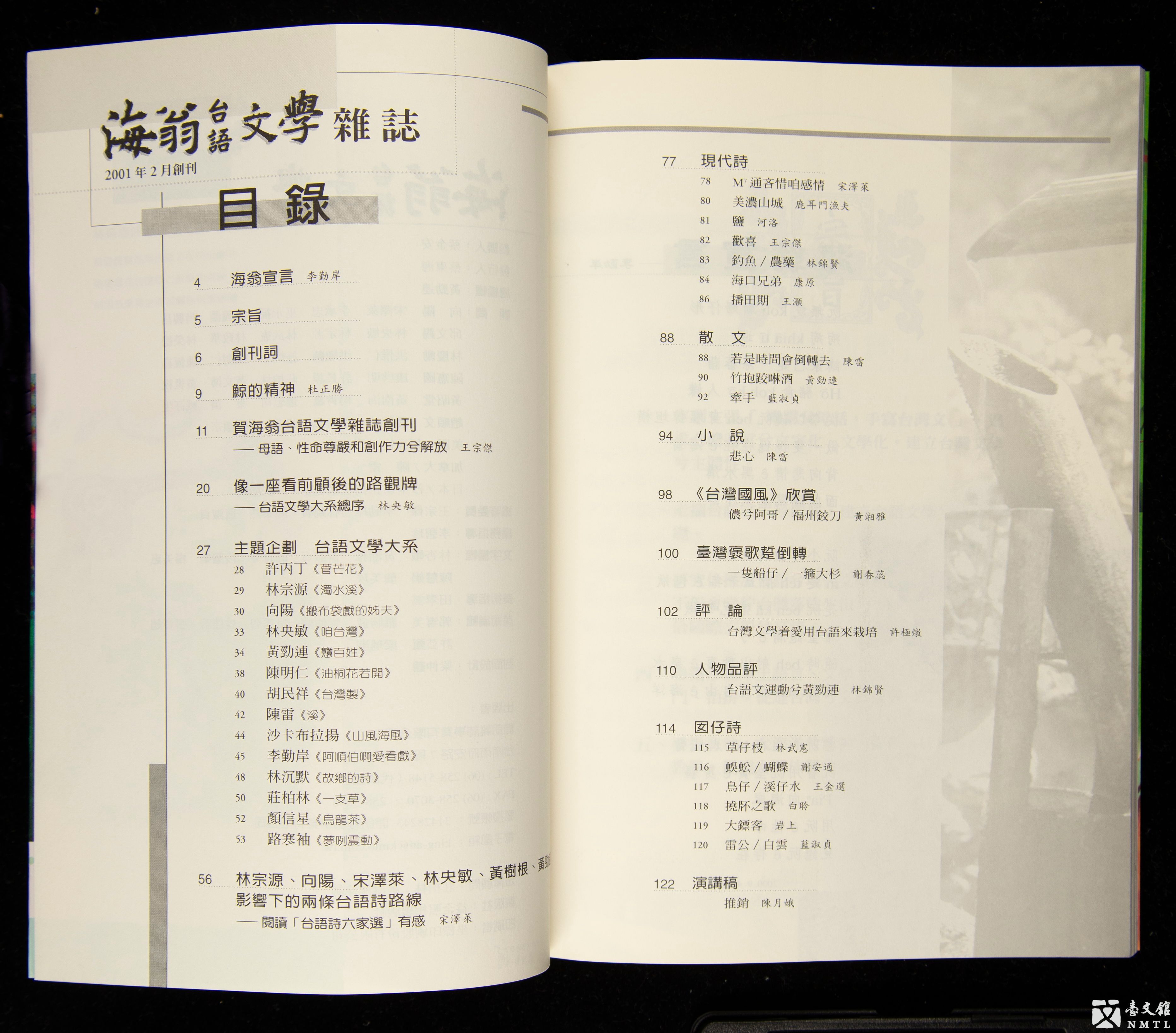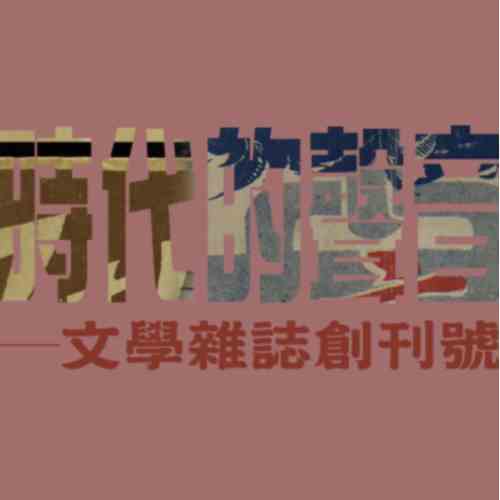Modern and classical poetry journals|Multiculturalism
The lifting of martial law and the ban on newspaper publications occurred on July 14th, 1987. In the meantime, social movements were thriving and the forms and themes of the journals were multiplied. This exhibition presents the Taiwan Indigenous Voice Bimonthly, which has devoted itself to promoting indigenous culture in Taiwan, as does the Taiwanese Literature Bong Gazette (Bong- pò), which contains works mainly written in the Taiwanese Hoklo language.
Modern and classical poetry journals
.jpg)
▸ The inaugural issue of Chien Kun Poetry Quarterly (Donated by Wang Chun-Bu)
The Quarterly was founded in January 1997, and it continues to be published by Chien Kun Poetry Quarterly Press in Taipei with the publisher Liu Bing-Yi, and the editorial board. (112 pages)
Chien Kun Poetry Quarterly was founded in the late 1990s, with a senior writer Zhou Bao-Nai as the president, Mo Ren, Ji Xian, Anonymous, Hu Pin-Qing, Long Guan-Jun, Hua Bing Lou Zhu as consultants. The foreword of the inaugural issue clearly revealed 10 articles of Chien Kun Poetry Quarterly, such as “we respect various genres because it is the poet's freedom to create,” “we oppose all schools and groups because it would limit the space for creation,” “there are only differences between the good and bad in poetry, and there are no differences between the new and old,” and “to appreciate modern (new) poetry as well as traditional (old) one.” It is a poetry journal with a combination of modern and traditional poetry, reviews, and the translation of world literature.
.jpg)
.jpg)
.jpg)
Multiculturalism
.jpg.jpg)
▸ The inaugural issue of Taiwan Indigenous Voice Bimonthly (Donated by Lin Jin-Peng’s family)
Taiwan Indigenous Voice Bimonthly was founded on November 5, 1993, with 156 pages. It was published by Aboriginal Cultural Development Association of the Republic of China, with Sun Da-Chuan as the editor-in-chief. The journal is still being published. Taiwan Indigenous Voice Bimonthly was the first publication in Taiwan that was spoken and written by the aborigines, with its focus on “aboriginal, literary, artistic, cultural, and worldwide.” In June 1993, the “Taiwanese Indigenous Peoples Development Association of the Republic of China” was established by the legislature. Hua Jia-Zhi was the first chairman of the board of directors, and the Taiwan Indigenous Voice Bimonthly Press was established. In November of the same year, the first issue of Taiwan Indigenous Voice Bimonthly was published. Sun Da-Chuan was the editor-in-chief, and the editorial committee members contained Kong Wen-Ji, Dannaifu-Jingruo, Tuobasi-Tama Pima, Adao-Balafu, Pu Zhong-Cheng, Xiaman-Lanpoan, Gao De-Yi and so on. Most of them are aboriginal writers or literary researchers who emerged from the Taiwanese literary world in the 1990s. The core concept was to promote the reconstruction and inheritance of aboriginal culture, and to provide space for discussion of ideas through the use of words, in order to seek space for aboriginal cultures.
In the first issue, there are 12 columns, such as “Shanhai topic,” “Shanhai commentary,” “Shanhai literature,” “Shanhai art,” “Shanhai theory,” “Shanhai medical,” “Mainland China and Taiwan,” "International indigenous issue,” “Historical silhouette,” “History of the tribe,” “Shanhai Log” and “Shanhai Season.” The journal covered a wide range of issues related to aboriginal people. Among them, it was particularly noteworthy that the the journal released aboriginal people’s works by the use of Chinese language, mother tongue, and traditional literature. It not only responded to aboriginal writers' involvement in contemporary literary circles in Taiwan, but it also inspired many different generations of aboriginal creators. The magazine ceased publication in 2000, a total of 26 issues were published, including 3 issues as bound editions (the 21st and 22nd, 23rd and 24th, 25th and 26th issue). A total of 39 aboriginal writers were published through the 7 years of the publication. The journal also hosted or co-sponsored some aboriginal literature awards, such as the first “Shanhai Literature Award” in 1995 and the first “China Automobile Aboriginal Literature Award” in 2000, to greatly enhance the visibility of aboriginal literature and it accumulated a wealth of literary achievements.
.jpg)
.jpg)
.jpg)
◆ ◆ ◆
.jpg)
▸ The inaugural issue of Taiwanese Literature Bong Gazette (Bong- pò)/TGB Newsletter (Donated by Chen De-Hua)
Taiwanese Literature Bong Gazette (Bong- pò)/ TGB Newsletter, founded by the Students’ Association for the Taiwanese Hoklo language, began publication on October 1, 1999 with the layout of 3 newssheets (12 pages). It is currently in circulation.
The Students’ Association for the Taiwanese Hoklo language officially was established in May 1992 right after the intense discussions among colleges in Taiwan on the social movement among the research academies and the Taiwanese Hoklo language. In September, Taiwanese Hoklo Language Student (1992-1995) began publication. In 1999, this association began to use “TGB” as its abbreviation. After holding the third National High School Students’ Camp for the Taiwanese Hoklo Language at a Bunun tribe in Taitung, Taiwanese Literature Bong Gazette (Bong- pò), also known as the TGB Newsletter, was founded in October of the same year, in order to maintain contact with the students who participated in the camp and to encourage the participants to keep writing and reading in Hoklo.
TGB is short for “Tâi-gú B äng,” meaning the net/dream of Hoklo. Taiwanese Literature Bong Gazette (Bong- pò)/ TGB Newsletter is a left-wing publication writing in Hoklo. In addition to political critiques and the critical articles on social movements, prose, fiction and other literary works are sometimes released in this journal. The contents of this journal are written in Taiwanese Romanization (Church Romanization) with the layout of 14.8 x 21 cm, and the number of pages in each issue is irregular. The editor-in-chief was Chen De-Hua at the beginning, and later changed to Tōa-thâu-liân starting from the 29th issue. This journal started as only an internal newsletter of TGB and later expanded to an external audience. In 2002, the official website was established, and soon the Internet became the main method for communication. The contents initially were bilingual, based on the full Taiwanese Romanization and Chinese-Taiwanese Romanization. Later, the contents were changed mainly to Chinese-Taiwanese Romanization. From the 61st issue (October 2004), this journal was revised and changed to use Holko-Chinese. From the 84th issue, the journal began to receive and release the articles written only in Chinese.
.jpg)
.jpg)
◆ ◆ ◆
.jpg)
▸ The inaugural issue of Whale of Taiwanese Literature Bimonthly (Donated by Lin Jin-Ping’s family)
Whale of Taiwanese Literature Bimonthly started publication in February 2001 by Cheerful Magazine Press, and it continues to be published. Its founder is Cai Jin-An, with the editor-in-chief Huang Jin-Jian. From the 13th issue published in January 2003, it was changed into a monthly, and the selected works of each issue are recorded. The disc of the recorded works are attached to the book, and the journal became a sound magazine and was renamed Whale of Taiwanese Literature Monthly. From the 81st issue published in September 2008, the journal has maintained its form as a pure monthly without sound discs. Moreover, the journal has received grants from the Cultural Construction Committee of the Executive Yuan and the National Museum of Taiwan Literature.
Whale of Taiwanese Literature Monthly is mainly based on the Taiwanese Hoklo literary works. The contents cover research discourse, modern poetry, proses, fictions, scripts, poems for children, fairy tales and the Taiwan customs. It provides a publishing field for Taiwanese Hoklo writers and researchers and makes a profound contribution to the Taiwanese Hoklo literature movement.

.jpg)









